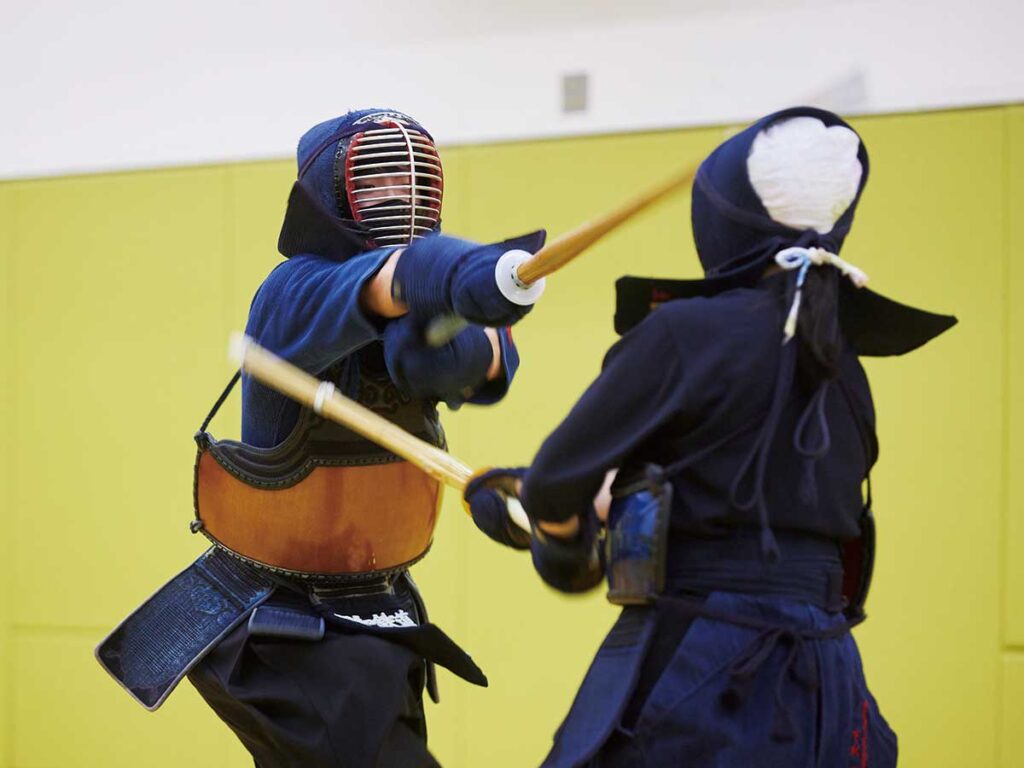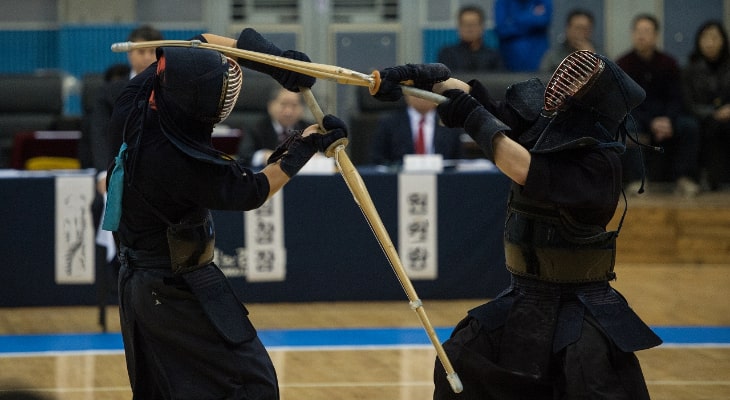
One of the appeals of Jodan kame in Kendo is its unique posture and tactics.
However, many swordsmen have a question about whether Jodan kamee is really suitable for them.
In this article, entitled “What are the characteristics of people who are suited to Kendo upper-dan stance?Explaining the secret to success,” we will introduce the basic knowledge of upper-dan stance, the characteristics of people who are especially suited to this stance, and the success of this article. We will provide a wide range of explanations, including tips on how to do this and practice methods to master it.
Gain a deep understanding of Jodan stance, find the stance that suits you, and aim to improve your Kendo technique and spirit.
目次
- 1 What is Jodan stance in Kendo?
- 2 Advantages of choosing upper stance
- 3 Characteristics of people who are suited to Jodan no Kamae
- 4 Physical characteristics of people who are suitable for Jodan no Kamae
- 5 Psychological characteristics of people who are suited to Jodan no Kamae
- 6 What to keep in mind when taking Jodan no kamae
- 7 Successful examples and analysis of Jodan no Kamae
- 8 Successful examples and analysis of Jodan no Kamae
- 9 Techniques and strategies for success with Jodan no Kamae
- 10 Training method to master Jodan no Kamae
- 11 basic practice
- 12 Applied practice
- 13 Points to keep in mind during daily practice
- 14 Offensive and defensive strategy in Jodan stance
- 15 Tips for attacking in Jodan stance
- 16 Points to note when defending in Jodan stance
- 17 Countermeasures against opponent’s stance
- 18 Frequently asked questions (FAQ) about Jodan no Kamae
- 19 Frequently asked questions (FAQ) about Jodan no Kamae
- 20 Misconceptions that beginners often fall into
- 21 Timing to shift to Jodan stance
- 22 summary
What is Jodan stance in Kendo?
In Jodan stance, the Shinai is held high above the head. From this stance, you can directly unleash a big blow.
The basic stance is as follows:
- Place your feet shoulder-width apart and place your right foot in front of you. Keep your center of gravity slightly back in the center.
- Hold the handle of the shinai in front of your abdomen with your right hand, and hold the shinai high by raising your left hand above your head and slightly forward.
- The tip of the shinai is pointed at the opponent’s throat to indicate the intention to attack.
- Keep your gaze fixed on your opponent’s eyes, maintain overall balance, and be ready to attack or defend at any time.
Advantages of choosing upper stance
The main benefits of choosing Jodan stance are:
- Overwhelming attack range : From the upper stage, you can unleash a larger blow against your opponent. The wide attack range makes it difficult for the opponent to defend.
- Providing a sense of mental pressure : Jodan stance is an aggressive stance, and this alone can put mental pressure on your opponent.
- Deploying a variety of techniques : From the upper stance, you can not only attack directly, but also perform various irregular techniques and feints. You can make attacks difficult to predict and confuse your opponent.
- Ease of transition to defense : Being ready to attack allows you to quickly move to defense if needed. Also, while launching an attack, it is possible to check the opponent’s attack.
The upper stance requires high skill and physical strength from the user, but its wide attack range and mental pressure can give the opponent a big advantage.
With practice and experience, you will be able to demonstrate the true value of this stance.

Characteristics of people who are suited to Jodan no Kamae
Jodan kame is a particularly aggressive stance in kendo, and swordsmen who choose it exhibit certain physical and psychological traits.
It’s important to know these characteristics to understand whether this stance is right for you.
Physical characteristics of people who are suitable for Jodan no Kamae
The following physical characteristics may be advantageous in using Jodan kame effectively:
- People with long arms : Long arms allow you to reach opponents farther away and increase the reach of your attacks.
- People with strong upper bodies : Jodan stances use a lot of strength in the upper body, especially the shoulders and arms. A strong upper body allows for more powerful strikes.
- People with physical strength : Jodan stances can easily drain your physical strength, so you need to have stamina and the stamina to maintain performance even during long matches.
Psychological characteristics of people who are suited to Jodan no Kamae
Psychologically, there are also some qualities that make Jodan kamae suitable:
- Aggressiveness : In order to take an aggressive stance, it is important to be willing to go out and get points.
- Calmness : Calmness is necessary in order to carefully observe your opponent’s movements and launch an attack at the right time.
- Confidence : Without solid confidence in your skills, it will be difficult to make bold attacks. It is important to be confident.
What to keep in mind when taking Jodan no kamae
When taking Jodan stance, you need to have the following mindset:
- Determination to overwhelm your opponent : It is important to actively control the game yourself and have the will to put pressure on your opponent.
- Calmness in assessing situations : In order to identify opportunities for attack, the ability to calmly analyze the situation is required.
- Flexible thinking : In addition to one-sided attacks, you need the flexibility to incorporate defense and countermeasures depending on the opponent’s movements.
- Concentration : Maintaining concentration without missing a moment is the key to a successful attack.
Jodan stances have many physical and psychological demands, so it is important to understand them and choose a stance that suits you.
By finding a stance that makes the best use of your own characteristics, you will be able to maximize your results in Kendo.

Successful examples and analysis of Jodan no Kamae
Jodan no Kamae is a unique attack stance in Kendo, and historically there have been many swordsmen who have achieved great success with this stance.
Here, we will look at successful examples of Jodan no Kamae, their analysis, and techniques and strategies for achieving success with Jodan no Kamae.
Successful examples and analysis of Jodan no Kamae
Historically, one of the swordsmen who was famous for his jodan kamee was Hiromichi Nakayama, who was active from pre-war to post-war.
He mainly used Jodan stance and won many matches with his overwhelming attack power and strategy.
Hiromichi Nakayama is particularly known for his tactics that make full use of “uchikomi” and “push”, which he uses to overwhelm his opponents and develop advantageous battles.
Hiromichi Nakayama’s success lies not only in attacking from the upper stance, but also in reading his opponent’s psychology and controlling their movements.
His tactics demonstrate that Jodan no Kamae is not just a physical position, but a strategy for establishing mental superiority.
Techniques and strategies for success with Jodan no Kamae
The following techniques and strategies are essential to success with Jodan Kamae:
Technical aspect
- Mastery of sense of distance : Attacks from the upper stance have a long reach, so it is necessary to have an appropriate sense of distance and the ability to accurately judge the distance between you and your opponent.
- Quick strike : A blow from the top requires a large swing, but at the same time it requires the skill to strike quickly. It is important to have both speed and power in your strikes.
- Feint techniques : Make full use of feints to deceive the opponent and shift the timing of the actual attack to break down the opponent’s defense.
Strategic aspect
- Maintaining pressure : By constantly making the opponent feel pressure from the upper stance, this increases the mental burden on the opponent and invites mistakes.
- Use of irregular techniques : In addition to direct attacks from the upper stance, it is important to use irregular techniques to confuse the opponent. This makes attacks difficult to predict.
- Mental strength : Since the Jodan stance is an aggressive stance, it is necessary to maintain the stance with confidence and mental strength. You need to have faith in your own attacks and not give in to the pressure of your opponent.
Success in Jodan Kamae is possible by mastering these techniques and strategies, as well as gaining experience in actual combat.
This aggressive stance in Kendo requires a comprehensive strategy that includes not only technical aspects but also psychological warfare.

Training method to master Jodan no Kamae
Jodan stance is a particularly powerful and aggressive posture in Kendo.
In order to master this stance and utilize it in actual combat, it is important to train step by step from the basics to advanced techniques.
During daily practice, you need to pay attention to certain points while practicing.
basic practice
The basic practice for mastering Jodan Kamae begins with learning the correct form.
- Accuracy of stance : The first priority is to learn the correct Jodan stance. Use a mirror to check your stance and be open to your instructor’s feedback.
- Basic batting practice : Repeatedly practice basic batting from upper stances (men, kote, torso, etc.). Start out slowly, focusing on accuracy, and gradually increase your speed.
- Strength training : Jodan stance uses a lot of strength, especially in the upper body. It’s important to include exercises that strengthen the muscles in your shoulders, arms, and back to increase your endurance.
Applied practice
Once you have mastered the basics, you can use them in actual combat through applied practice.
- Practicing moving strokes : Practice moving forward and backward from the upper stance. Make sure to strike accurately while reading the distance between you and your opponent.
- Practicing irregular techniques : Practice attacks that include feints and changes in techniques. Let’s hone your techniques to confuse your opponent.
- Practical practice : Practice in a format that simulates an actual match, and experience attacking and defending from Jodan stance. Learn to read your opponent’s movements and balance attack and defense at the right time.
Points to keep in mind during daily practice
- Posture and Balance : Always try to maintain your posture and balance. An unstable stance will reduce the accuracy of your attacks.
- Mental concentration : Jodan stance also requires mental strength. During practice, always keep your concentration high and try to make calm decisions.
- Repetitive practice : Techniques from Jodan stance are honed through repeated practice. Let’s make improvements little by little through daily practice.
- Self-analysis : After practice, reflect on your own movements and tactics and find areas for improvement. If possible, it is also effective to videotape the rehearsal and visually analyze it.
In the process of mastering Jodan stance, the most important thing is to practice patiently.
With consistent effort in the right way, you can turn attacks from Jodan stance into powerful weapons.

Offensive and defensive strategy in Jodan stance
The Jodan stance is an aggressive and overwhelming stance in Kendo.
Attacking and defending from this stance requires unique strategies.
Here, we will explain offensive and defensive strategies using Jodan stance, tips for attacking, points to note when defending, and countermeasures against your opponent’s stance.
Tips for attacking in Jodan stance
The key to attacking from the upper stance is to take advantage of its incredible reach and pressure.
- Read your opponent’s movements : Carefully observe your opponent’s movements and reactions to determine the best time to attack.
- Use feints : In addition to direct attacks, use feints to induce a reaction from your opponent and create an opening.
- Increasing the decisive power of a blow : A blow fired from the upper stance is expected to produce a decisive effect with its strength and speed. When striking, try to shift your weight effectively and use your entire body to deliver a powerful blow.
Points to note when defending in Jodan stance
Jodan stance requires you to maintain an aggressive stance while also paying attention to defense.
- Control your distance : Maintain a distance that is advantageous to you, and maintain a position that is difficult for your opponent’s attacks to reach.
- Increase reaction speed : React quickly from the upper stance, allowing you to respond quickly to your opponent’s attacks. This requires constant vigilance and preparation for your opponent’s movements.
- Be aware of counter attacks : While dodging your opponent’s attacks, be aware of counter attacks that exploit the gap. This requires the insight to understand the opponent’s attack patterns and respond flexibly to the situation.
Countermeasures against opponent’s stance
Changing your strategy depending on your opponent’s stance is the way to make the most of Jodan stance.
- Against the lower stance : Attacks from the lower stage are fast and can be difficult to hit. To counter this, take advantage of your long reach and apply pressure while keeping your distance, inviting the opponent to attack and aiming for a counter.
- Against Chudan stance : Chudan stance is the most balanced and is excellent both offensively and defensively. Here, it is important to use feints and speed to break down the opponent’s defense.
- Against other Jodan stances : In battles between Jodans, mental strength and technical refinement are the difference between victory and defeat. Leverage your strengths to gain the upper hand with calm judgment and instant attacks.
Fighting from a Jodan stance requires not only technical skills but also strategic thinking, so the ability to constantly analyze your opponent’s movements and respond flexibly is key.
By practicing while keeping these points in mind during your daily practice, you will be able to use Jodan no Kamae as a powerful weapon.

Frequently asked questions (FAQ) about Jodan no Kamae
Jodan kame is a unique and aggressive stance in kendo, and it is important to deepen our understanding of its characteristics and application.
Here we will discuss frequently asked questions (FAQs) about Jodan Kamae, common misconceptions that beginners make, and the right time to transition to Jodan Kamae.
Frequently asked questions (FAQ) about Jodan no Kamae
Q1: Is Jodan Kamae suitable for beginners?
A1: Jodan stance requires technical proficiency and physical strength, so it is generally better used by experienced players than beginners. However, it is beneficial to understand the basics of kendo when you first start learning the basics.
Q2: Do attacks from upper stance tend to be slower?
A2: Jodan stance tends to look like a big swing and is often thought to slow down the attack, but with proper practice and technique acquisition, it is possible to attack quickly and powerfully. In fact, a quick strike can put overwhelming pressure on your opponent.
Q3: Is the upper stance difficult to defend?
A3: Although the upper stance is an offensive stance, it can also be used as an effective defense if you have the appropriate distance and reaction speed. The important thing is to pay attention not only to attack, but also to defense.
Misconceptions that beginners often fall into
- Misconception 1: The upper stance is for attack only.
- The upper stance is an offensive stance, but it is also very effective for defense and countering. It is important to understand this as a stance that combines offense and defense.
- Myth 2: You can master Jodan stance right away.
- Jodan no Kamae is an advanced technique that requires understanding how to use properly and a lot of practice. You need to take your time and learn it carefully.
Timing to shift to Jodan stance
The appropriate time to transition to Jodan stance may be in the following situations:
- When your opponent is tired : When your opponent is tired and their defense is low, you can use the pressure from the upper stance to push them into a corner.
- When you want to apply mental pressure : Jodan stance can put strong pressure on your opponent, so it is effective when you want to change the flow of the match.
- When it is effective against the opponent’s stance or tactics : For example, when the opponent is in a low stance, it is effective to attack using the long reach from the upper stance.
It is important to read the battle situation and decide on the transition to Jodan stance after consulting with your own condition and tactics.
During actual matches and practice, imagine various scenarios and practice changing stances at the appropriate times.

summary
The Jodan stance in Kendo is a unique stance with an aggressive and overwhelming presence.
Its mastery and application in combat provides a technical challenge and strategic depth for swordsmen.
The key to mastering Jodan stance is to have a broad understanding of it, from its basics to its applications, offensive and defensive strategies, and points to remember in daily practice.
Learning and applying Jodan no Kamae
In order to master Jodan Kamae, it is essential to start by learning the correct form, practice basic batting, and work hard on strength training.
As applied practice, it is effective to practice moving strokes, practice irregular techniques, and practice in a real combat style.
Tips for attacking and precautions for defending
When attacking, it is important to read your opponent’s movements, use feints, and increase the decisiveness of your blows.
When defending, you need to control your distance, improve your reaction speed, and be aware of counter attacks.
Countermeasures against opponent’s stance
By taking countermeasures according to your opponent’s stance, you can make the most of the benefits of the upper stance.
It is important to understand the characteristics of your opponent’s stances and practice effective attack and defense strategies against them.
Points to keep in mind during daily practice
By maintaining posture and balance, focusing your mind, practicing repeatedly, and performing self-analysis on a daily basis, you can hone your techniques and strategies for Jodan kame.
Visual feedback through video recording of rehearsals is also effective in identifying areas for improvement.
By answering frequently asked questions about Jodan Kamae, you will be able to clear up common misconceptions that beginners fall into and help you determine the right time to transition to Jodan Kamae.
Learning the Jodan stance and applying it in actual combat greatly contributes to the growth of Kendo technique and spirituality.




